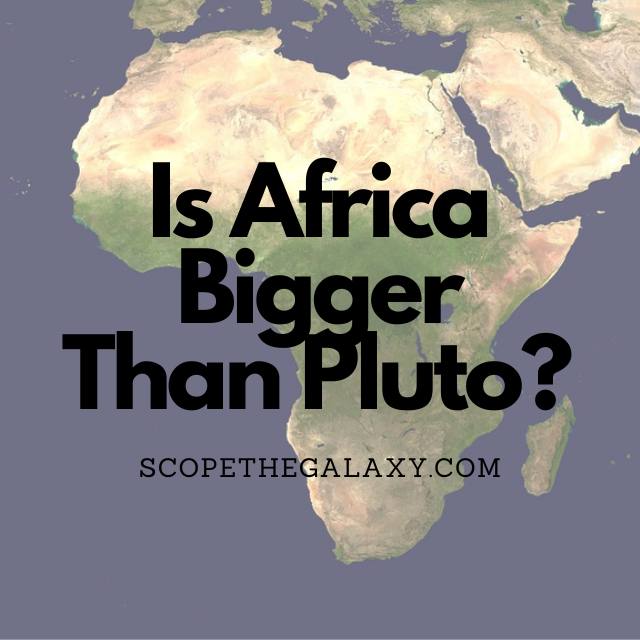*This post may contain affiliate links. This means we may make a commission if you purchase an item using one of our links*
Africa is the second largest of all Earth’s continents, whilst Pluto is a dwarf planet. Still, there’s no comparison regarding which one is bigger as Africa is a flat land mass with a surface area of 30.3 million square kilometers and a volume of 1.12 billion cubic kilometers while Pluto is a spherical body with a surface area of 17.6 million square kilometers and a volume of 6.4 billion cubic kilometers.
Continue reading if you want a more detailed look at what makes both Pluto and Africa as big as they are.
How Big Is Africa?
Africa is the Earth’s second largest continent covering a total area of approximately 30.3 million square kilometers, equal to about 20% of Earth’s total land mass or 6% of the planet’s surface area. Africa possesses the world’s largest desert, plus it has the longest river of any continent, the Nile.
Africa is the second highest populated continent on Earth. The continent has 54 countries, including Egypt, Nigeria, and Kenya, and it accounts for roughly 17% of the world’s population, with more than 1.4 billion people.
There are eight main physical regions of Africa: the Sahara, the savanna, the rainforest, the Great Lakes, the Sahel, the Ethiopian Highlands, the Swahili Coast, and southern Africa. The Sahara Desert extends over the northern third of Africa and is one of the most inhospitable places on Earth. Its size is 9.2 million square kilometers – roughly the same size as the entire United States.
The African savannah is a vast grassland that covers most of the African continent (around 65%). It extends from the Red Sea at the east to the Atlantic Ocean in the west and from Senegal in the north to Sudan in the south.
A savannah is a type of landscape that consists of grasslands with few trees, bushes, or shrubs. The grasses are typically short but can grow up to almost four meters tall. The dominant vegetation is acacia and baobab trees, which provide shade and shelter for animals during daytime hours.
Africa possesses some of the world’s highest mountains; Mount Kilimanjaro is the tallest, which rises 19,341 feet from its base near the equator to its peak in Tanzania. Africa extends to a length of 8,000km between its northern and southern extremities in Tunisia and South Africa; its width of 7,400km stretches from Xaafuun Point in Somalia to Almadi Point in Senegal.
The thickness of Earth’s crust ranges from 5 to 70km and is generally thicker under continental land where it averages 40km. Taking this figure and multiplying it by Africa’s surface area, we can calculate the rough volume of the continent at 1.21 billion cubic kilometers. This might sound like a sizable volume, but it’s no match for the 6.4 billion cubic kilometers of Pluto’s volume.
How Big Is Pluto?
Even though Pluto is a planet, which would have most individuals automatically assume it to be bigger than most if not all countries or continents on Earth, this won’t always be the case, especially when looking at different measurements to determine its size.
For the longest time it was assumed that Pluto, the now officially recognized dwarf planet, had a surface area smaller than the largest know country on Earth, Russia.
This is because prior to the newest mission in 2015, it was estimated to have a surface area of 16.7 million km² but the New Horizons launch, which observed the planet in more detail than even before, came to a more accurate calculation of the dwarf planets surface area, coming out to be 17.6 million km².
Pluto does not have an excessive number of mountains on its surface nevertheless, some of its ice capped mountains are rather tall with certain mountain ranges reaching peaks as high as 3.55km.
In regards to the planets overall thickness, taking into account Pluto’s diameter of 2,376.6km, it would be many times the thickness of every country within Earth, whether it be Russia, Canada, the United States and so on.
All in all, even if purely based on surface area Pluto is similar to that of the largest continents on Earth and possibly even smaller than some of the continents(like Asia) on our blue sphere however, when thickness and volume comes into play, Pluto blows all of them out of the water.
After all a volume of 6.4 billion cubic km is nothing to scoff at, and hardly a number that the majority if not all the flat land on Earth could even combine to beat.
Summary
Africa is the second largest continent on Earth so it makes sense that many would think that it could be bigger than Pluto, which it is s when only the surface area is taken into account.
However, when you consider the pure volume of each entity, Pluto is almost 6 times that of the African continent as it is a spherical object whereas Africa is simply a very large but flat land mass.

